Humanoid Cylon: Difference between revisions
More actions
Gordon Ecker (talk | contribs) |
Gordon Ecker (talk | contribs) |
||
| Line 164: | Line 164: | ||
A child, [[Kacey]], is presented by a Conoy model to [[Kara Thrace]] as an hybrid offspring purportedly created with their genetic material in the episode "[[Occupation]]". The Cylons' ruse is revealed when Kacey's human mother later claims the child ([[Exodus, Part II]]). | A child, [[Kacey]], is presented by a Conoy model to [[Kara Thrace]] as an hybrid offspring purportedly created with their genetic material in the episode "[[Occupation]]". The Cylons' ruse is revealed when Kacey's human mother later claims the child ([[Exodus, Part II]]). | ||
[[Nicholas Tyrol]] is also presumed to be a Cylon / human hybrid ([[Crossroads, Part II]]), as there has been no indication that his biological father is anyone other than [[Galen Tyrol]]. | |||
== Speculated Infiltrators == | == Speculated Infiltrators == | ||
Revision as of 06:36, 27 March 2007
- For information on the robotic Cylons of the Original Series, see Cylons (TOS). For information on a human-appearing Cylon from Galactica 1980, see Andromus.

Humanoid Cylons[1] are the quintessential Cylon form in the Re-imagined Series. These Cylons mimic human form so completely that they are nearly undetectable to current Colonial technologies.
Humanoid Cylons have the capacity to emulate many human physical acts, including sex. They also display convincingly human personalities (affection, jealousy, sadness, anger, sense of humor, religious faith etc.) This behavior continues even when interacting with other Cylons outside of Colonial scrutiny, clearly establishing that their personalities are genuine.
The Humanoid Cylons are responsible for masterminding the complete destruction of the Twelve Colonies through their use of sabotage and infiltration.
Origins
Following the end of the Cylon War (Miniseries), nothing was heard of the Cylons in 40 years.
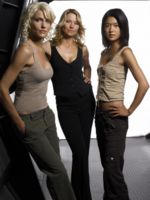
During their forty years of isolation, the Cylons developed or evolved into a humanoid form[2].
The creation of the humanoid Cylon is left to speculation based on series events. While the opening credits claim that the Cylons "evolved", the concept of biological evolution (in the Darwinian fashion) is impossible with mechanical beings. The "evolution" is obviously a planned architectural change from the mechanical to the biomechanical for the inherent Cylon design.
The original Cylon, the Cylon Centurion Model 0005, a sentient robot, is likely to have had a major, if not a sole role in the creation of the humanoid forms.[3] Number Three's conversation with Cavil immediately before she was boxed indicates that the humanoid Cylons do not know who programmed them or why.[4]
Series information shows that the humanoid Cylons existed in secret for at least two years prior to the Colonies' destruction. This information does not provide concrete evidence as to when the first models were created and how long they have been among the human population. There is also no evidence as to whether all the 12 models were created at once or whether they were created at different times during the forty year exile.
Physiology and Psychology
Humanoid Cylons are visually indistinguishable from humans, down to the cellular level, but not completely at a molecular level. Dr. Gaius Baltar is able to create a detector that can distinguish Cylon from human, but rarely used the device to a positive end (Tigh Me Up, Tigh Me Down).
Each humanoid Cylon has the same face, stature, hair, eye and skin color, gender, and other biometrics as all the others of his or her model. This point technically makes each copy a twin of itself, but there are some models that choose to make cosmetic differences. Examples include D'Anna Biers, Gina and a Number Six model with black hair (Torn). As well, each copy appears to start with the same basic personality, but each personality grows more distinct due to their individual experiences.
Humanoid Cylons can be programmed as 'sleeper agents', who appear to have a low-level Cylon personality that can conduct operations while placing the human sleeper personality "on-hold." "Boomer" Valerii was one such agent (Kobol's Last Gleaming, Part II). Most agent copies, particularly Numbers Five and Six, assume a human persona but are fully aware of their true nature and behave more or less as a human "spy."

They are susceptible to the same emotional traumas and joys that their human counterparts are, further proving that personalities are a realistic part of their psyche. A case in point is a copy of Number Six, known as Gina, who is physically and sexually assaulted repeatedly by the crew of Pegasus. These repeated assaults lead to Gina's near-catatonic state at the time Pegasus discovers the Fleet (Pegasus).
Humanoid Cylons can dream, a process that appears to be natural to them[5].
Some or all Cylon female models may have the capacity to bear children seeded by human males ("33", "Flesh and Bone", "The Hand of God", "Kobol's Last Gleaming, Part II"). The Cylons tested numerous methods of sexual reproduction, yet these failed due to a known flaw in their design. Humanoid Cylons cannot reproduce with each other biologically, so in an attempt to subvert this deficiency, they try to interbreed with humans, creating hybrid offspring. "Farms" were set up across all the occupied Colonies where survivors, specifically, young fertile women of child-bearing age, were rounded up, placed under heavy sedation and turned into "baby machines" through artificial insemination[6]. However, this methods have been unsuccessful thus far. Another drastically different approach is taken by attempting to conceive a child through a bond of love. It seems that Helo and Athena's love-child is the lone success story of the relatively short history of Cylon sexual reproduction (The Farm).
The bodies of humanoid Cylons sometimes appear to have tremendous stamina and strength, and appear to be designed to destroy or resist commonly dangerous human diseases[7], although they are not immune from all contagions[8]. In keeping with their desire to be a better human, however, the Cylons did not or could not further improve on other characteristic design flaws of the human body.[9] Humanoid Cylons are heavily fortified to resist damage from intense radiation fields that would kill a human after short exposure (The Passage), but they are still susceptible to damage from certain types of radiation or trauma (Miniseries). Despite their resistance to certain forms of energy, Humanoid Cylons, unlike the Cylon Centurion, cannot be made "bulletproof" ("Precipice", "Hero").
The majority of the Cylons follow a monotheistic religion (with the possible exception of the Cavil model, which appears to be an atheist).
Cybernetic Behavior

Upon the death of its body, a humanoid Cylons transfers its consciousness into another copy of itself. This "resurrection" is limited by distance, signal integrity, and proximity to the Cylon homeworld or a Resurrection Ship (Miniseries, "Flesh and Bone," "Resurrection Ship, Part II").
It appears that all humanoid Cylons share a collective knowledge base of data from other active or deactivated humanoid Cylons, regardless of their model.[10]
Their psychology is based on what they simply refer to as "projection". Essentially an enhanced form of a self-induced and controlled hallucination, projection is how they choose to see the world around them, in any form they wish, whenever they wish. For example, if a Cylon were standing in a hallway, they could choose to see it as a forest filled with birds, trees, and sunlight. This mode of visualization is pleasing to agents (Torn)[11].
Although they cannot do so remotely or wirelessly, Humanoid Cylons can interface with a computer system or computer network by photo-electronical means. They can perform this through subdermal physical contact if required (Flight of the Phoenix) or, preferably, through a Cylon data port[12]. This might be possible through the use of bio-luminescent and photosensitive cells in their hands.
The presence of a water-like fluid as an integral part of the basestar, the ability to interface photo-electronically through subdermal and dermal contact, and the fact that humanoid Cylon are anatomically indistinguishable from human beings, implies that the techniques used in their creation are advanced enough to incorporate cybernetic functions into their design without the use of specific internal structures other than human-like organs.
Known Cylon Models
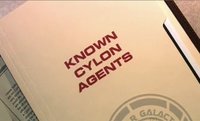
There are twelve models of humanoid Cylons (Miniseries), representing twelve personality archetypes that the Cylons have witnessed in humanity. All seven models revealed to the viewers as Cylons[13] have also been revealed to the central Colonial characters as of the episode "Collaborators". The identities of the final five remaining Cylon models are unknown to both humanity and the seven known models.
There are many copies of each model, although the specific number of copies per model has not been specified. There appears to be no significance to any of the specific numbers assigned to the different Cylons, although Number Six did refer to Boomer (Eight) as "little sister" upon her download (Downloaded). [14]
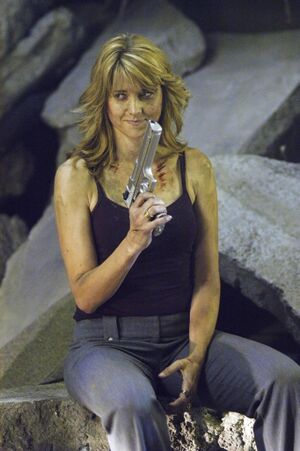
First seen posing as a reporter from the Fleet News Service, this model is revealed to be a Cylon at the end of "Final Cut" when a second copy is shown living on Caprica. Threes seem to be the most calculating and duplicitous models shown to-date, even manipulating and deceiving other models if they feel warranted. The copy that tried to box Sharon Valerii exhibited these characteristics strongly in the episode, "Downloaded."
This model's status as a Cylon is unknown to the Colonials until either shortly after the rescue of the surviving members of the Caprica Resistance (Lay Down Your Burdens, Part II), or after the Cylon occupation of New Caprica (Lay Down Your Burdens, Part II.)
After the Threes defy other Cylon models in their attempt to discern the identity of the five missing Cylon humanoids, the other Cylons conclude that the Three model has an inherent flaw that threatens their overall reliability. After the failure on the algae planet to gather information on the path to Earth, the Cylons have all Number Three models boxed indefinitely.
A copy of this model has appeared under the name/alias "D'Anna Biers."
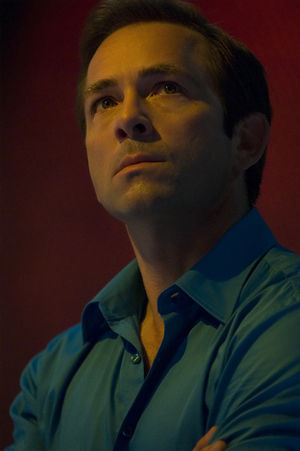
This model attempts to sow the seeds of discontent or confusion, particularly during crucial life-threatening situations, and endeavors to undermine authority that threatens his objectives (Miniseries). Number Five models are more covert, assuming an ordinary "everyman" appearance that's blended in what may seem to be insignificant behind-the-scenes issues (such as converting Galactica into a museum). Of all the models thus far, the Number Five models are the most militant, fanatic and consistent in message and objectives to the Cylon objectives, whether he is dispassionately discussing the fate of humanity with his comrades or attempting to kill or maim Colonials in a suicide bomb attack (Litmus).
Viewers first meet a Number Five during a tour of Galactica with other Colonial citizens (possibly the press) as we see the battlestar for the first time at the start of the Miniseries. Viewers aren't sure of Cylon's true identity until the Miniseries' conclusion.
Copies of this model have appeared under the name/alias "Aaron Doral".
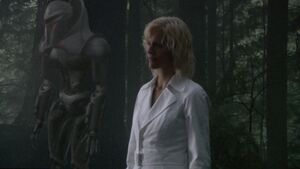
This is the first humanoid Cylon model shown to viewers at the start of the Miniseries.
This model utilizes the human need / desire for sexual relations to her advantage. She tends to be very religious and monotheistic. Model 6 desires to know what it is to be alive. There is something inherently enigmatic about her, more so than with the other models. Sixes have been described as "usually so hardcore", referring to their tendencies towards violence.
Typically she is the alpha female, as demonstrated on multiple occasions (Miniseries, 33, Water, Six Degrees of Separation).
Copies of this model have appeared under the names/aliases "Shelly Godfrey" , "Gina", and "Caprica" (in honor of her work on Caprica towards the destruction of the Colonies).
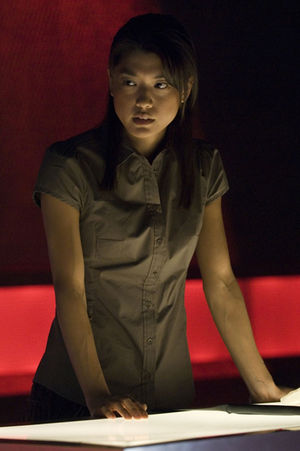
Number Eight is generally a saboteur designed to infiltrate Colonial military units and is likely programmed to use any Colonial munitions to cause havoc (Water). The Number Eight model is the closest witnessed Humanoid Cylon model to show its abilities as a soldier. This model has shown naiveté in many matters. She is apparently not as religious as other Cylon models, but has demonstrated that she can love, and is capable of being impregnated by a human (Six Degrees of Separation, Kobol's Last Gleaming, Part II).
She may be "defective", as the Cylon programming within the sleeper agent known as "Boomer" on Galactica conflicts multiple times with its human personality (Water). Also, the fully aware Sharon Valerii found by Helo on Caprica switches alliances from Cylon to Colonial after falling in love with Helo and aids the Colonials for a time (several episodes, most notably "Flight of the Phoenix"). Number Eight is the third Humanoid Cylon introduced during the Miniseries. However, viewers do not discover her true identity until the very end of the Miniseries when a second copy of Sharon Valerii appears at Ragnar Anchorage while retrieving an abandoned copy of Number Five.
A copy of this model has appeared under the name "Sharon "Boomer" Valerii." One copy, Sharon "Athena" Agathon, has defected from the Cylon and has joined the Colonial Fleet, generally replacing her "Boomer" counterpart as a Raptor pilot.
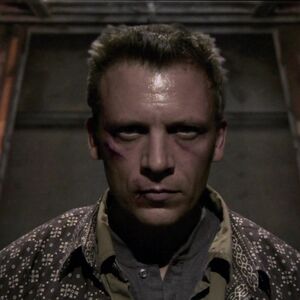
Leoben Conoy (model number unknown) is the fourth model witnessed by viewers (although viewers would not know until the end of the Miniseries that they had already seen the third introduced humanoid Cylon, Sharon Valerii). The Conoy model has shown to be religiously oriented and claims to be prescient on some level, using dogma and intermixing truth with falsehoods. It was first discovered on Ragnar Station, claiming to be a scavenger / arms dealer (Miniseries).
The Conoy models also appear obsessed with matters of mating, bonding, and reproduction, as demonstrated by a particular agent's fascination and obsession with Kara Thrace ("Flesh and Bone," "Lay Down Your Burdens, Part II," "Occupation," "Precipice," and "Exodus, Part II").
Conoy can be likened to the serpent of the Genesis tale in the Earth Christian Bible, taunting people with knowledge then watching as the negative consequences come into devastating fruition. Leoben copies have likely been encountered by the Caprica Resistance, as Samuel Anders recites in jest some comments made by another Leoben copy captured in the Fleet ("Flesh and Bone", "The Farm").
The Simon model (model number unknown) is encountered by Kara "Starbuck" Thrace on Cylon-occupied Caprica. Posing as a doctor, Simon was actually involved with the Cylon hybridization program. Simon resembles a tall, somewhat thin middle-aged black man who speaks in a comforting strong voice (The Farm) Unlike other models, Simon doesn't seem to have many military aspects to his physical or mental configuration, and was easily overcome by a wounded Thrace. Simon may be a model based primarily on human intellectualism and logic[15]. Simon is the only model out of the seven that has not as of yet been seen as an infiltrator in the Fleet.
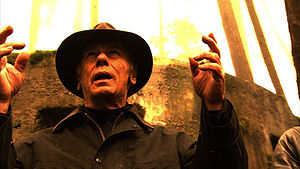
The Cavil models (model number unknown) posed as cynical Colonial priests in the Fleet.
Cavil models do not subscribe to the theology of the Cylons, but usually adhere to the party lines in group decisions. They have displayed a condescending attitude toward the beliefs of the other six known Cylons at times.
In several instances, the Cavils display dark, draconian solutions to the insurgency on New Caprica that equal the militant zeal of Numbers Three and Five.
Galen Tyrol discovered that he is a Cylon in Crossroads, Part II. No other copies have been seen.
Samuel Anders discovered that he is a Cylon in Crossroads, Part II. No other copies have been seen.
Saul Tigh discovered that he is a Cylon in Crossroads, Part II. Of all the known humanoid Cylons, Saul Tigh has the longest known history, dating back to the Cylon War. No other copies have been seen.
Tory Foster discovered that she is a Cylon in Crossroads, Part II. No other copies have been seen.
Human/Cylon Hybrids
Conceived by the Eight believed to be Sharon Valerii and Helo, the infant Hera Agathon is the first and only known human/Cylon hybrid[16].
Gaius Baltar's internal Number Six regularly insists that Hera is actually the child of herself and Baltar, though there is no physical reason yet presented to justify that claim.
For some time Hera was hidden away from both humans and Cylons, and believed to be dead by her parents. President Laura Roslin had the baby hidden with Maya as her adoptive parent. Despite Roslin's attempts to protect the child on New Caprica, Hera is later found by the Cylons (Exodus, Part II).
After Hera's mother discovers that her daughter is alive, she uses her ability to download to transport to the Cylon ships, and manages to convince Caprica-Six to return the child to Galactica for medical treatment for a possible intestinal blockage, which the Cylon doctors, lacking pediatric knowledge, were unable to comprehend (Rapture).
A child, Kacey, is presented by a Conoy model to Kara Thrace as an hybrid offspring purportedly created with their genetic material in the episode "Occupation". The Cylons' ruse is revealed when Kacey's human mother later claims the child (Exodus, Part II).
Nicholas Tyrol is also presumed to be a Cylon / human hybrid (Crossroads, Part II), as there has been no indication that his biological father is anyone other than Galen Tyrol.
Speculated Infiltrators
- See the Humanoid Cylon speculation article for analysis on characters and their likelihood of being a Humanoid Cylon, based on episode information.
Notes
- Ron D. Moore stated in an interview with TheFandom.com, "There is no original human Sharon. The idea is not that there was likely an original human model that they were copied from. The idea was that these models of Cylon were sort of developed out of their own study of us. The Cylons on some level looked at humanity and said 'You know what? There's really only 12 of you.' If these are the 12, and sort of if you look at them they each represent different archetypes of what humanity is." This established as canon that:
- There are precisely twelve human Cylon models. The other varieties of Cylon spacecraft or fighters are not factored into this count of 12 models.
- None of the Humanoid Cylons were ever an actual human.
- The twelve models are based on on archetypes determined by the Cylons that form what they perceive were the specific kinds of human behavior and/or personality, distilled into twelve varieties.
- A Cylon Centurion can not distinguish the differing versions of one model from another (Precipice). For example, if faced with two differing Number Eight models, Sharon "Boomer" Valerii and Sharon "Athena" Agathon, it would not be able to discriminate between them without external aid.
- While Centurions may not be able to tell the difference between different versions of the same model, other Humanoid Cylons do not have this problem ("Downloaded", "Exodus, Part I", "The Eye of Jupiter").
- According to Cavil in "Exodus, Part I", the pain associated with each successive download is worse than the one before. The first download feels like little more than a headache, but the third feels like someone has rushed a white hot poker through the head. However, this might be a subjective feeling that varies with model and circumstances. Sharon Agathon's report in "Scar" supports Cavil, but a Number Three considers her last download to be rejuvenating (Downloaded).
- In "Torn" Caprica-Six mentions that the Cylons do not talk about the final five Humanoid Cylons. In the same episode Gaius Baltar confirms that during his term as President on occupied New Caprica and on the basestar he is on, he only saw the first seven models.
See also
References
- ↑ Viewers initially lacked an authentic term to call the humanoid Cylons during Season 1. Here on the Battlestar Wiki, the descriptive term "Humano-Cylon" was used for a time. Dialogue in several episodes throughout Season 2 has canonically established "Cylon agent" to refer specifically to Cylon infiltrators, but since Sharon Agathon works for the Colonials, Battlestar Wiki's preference is to use "Humanoid Cylon" (which Tricia Helfer often uses in interviews, but apparently more for convenience than an official name). Some of the resistance fighters on Caprica refer to the humanoid Cylons as "skin jobs," an homage to Blade Runner.
- ↑ The idea of Cylons in humanoid form in Battlestar Galactica is not new. This concept appeared over 25 years earlier in the episode "The Night the Cylons Landed" in the short-lived spinoff of the Original Series, Galactica 1980. Unlike the humanoid Cylons, however, Andromus was an android, akin to the character of Data from Star Trek: The Next Generation.
- ↑ Information noted from the start of Miniseries (the existence of the Armistice Station) indicates that the original Cylons were not only sentient, but capable of intense emotion. William Adama confirms that the new robotic successor to the Model 0005 were built by the Humanoid Cylons without sentience to avoid the possibility of the new Cylon Centurion from creating an overthrow attempt at their humanoid masters.
- ↑ The final scene of Rapture.
- ↑ A Number Three speaks casually to Doctor Cottle about her prophetic dreams of the child Hera in "Exodus, Part I."
- ↑ Ron Moore said there are presumably also farms for male humans, plus in vitro experiment labs, etc.
- ↑ The blood from Hera's fetus destroys the cancer within Laura Roslin's body in "Epiphanies."
- ↑ An infection ravages the Cylons in the episode, "Torn".
- ↑ Dr. Cottle complains of birth complications with Caprica-Valerii in the episode, "Downloaded".
- ↑ A collective knowledge base works more like an internet chat forum, or even a wiki, which differs from the concept of the collective consciousness as seen in SciFi species such as the Borg in Star Trek. Writers of the show have indicated this type of "hive mind" is not employed. Many Cylons are seen describing or detailing events that one of the models experienced but did not participate, such as Caprica-Valerii's description of meeting Kara Thrace for the first time--a memory physically experienced not by that Number Eight copy, but "Boomer" Valerii, in "Kobol's Last Gleaming, Part II. When under duress, "Boomer" Valerii is able to tell Gaius Baltar the number of remaining Cylon agents in the Fleet. This information would be impossible to know without a collective knowledge base to all humanoid Cylons (Resistance)
- ↑ Gaius Baltar's dreamlike interactions with his virtual Number Six is strikingly similar to Cylon projection. See the article, Baltar as Cylon speculation for more on this issue.
- ↑ Sharon Agathon steals back the Fleet's launch keys by infiltrating a Cylon base by using a Cylon data port. Humanoid Cylons are seen operating a basestar in the episode "Torn" by touching an optical pad that illuminates these arm interfaces.
- ↑ The term "Known Cylon Agents" is shown on a dossier on the models shown on Laura Roslin's desk on Colonial One in the episode "Epiphanies."
- ↑ On Ronald D. Moore's blog on Scifi.com, he stated that "Number Six was specifically a homage to 'The Prisoner,' but the rest [of the Humanoid Cylons] were assigned their numbers randomly."
- ↑ A Simon expresses the moral dilemmas of rescuing a crippled basestar as having no scientific answer in "Torn."
- ↑ These beings should not be confused with the living computer of a basestar, also called a Hybrid.
